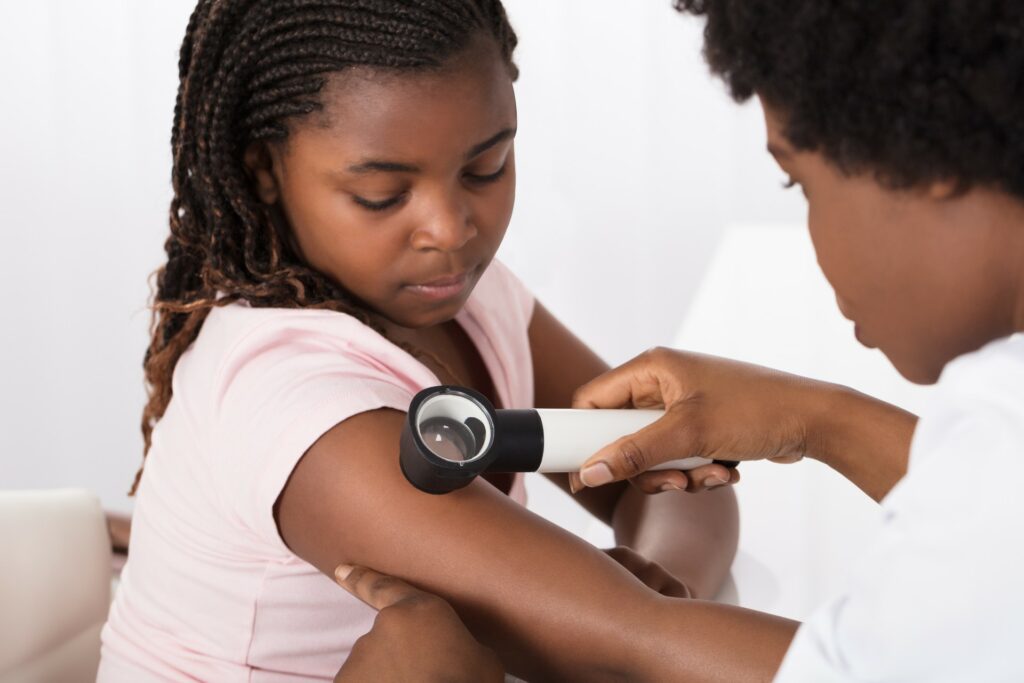Dermatologists Help Families Navigate Pediatric Skincare

When a baby enters the world, doctor visits become part of the weekly schedule. As children grow, doctor and dental visits aren’t a second thought. Many schools require physicals and annual checkups to ensure children get the medical attention they need and that any concerns can be addressed early on. If a child is ill, they go to the doctor for a checkup and medication when necessary. So, why wouldn’t families with children dealing with skincare concerns and issues go to a dermatologist for guidance and care? Dermatology is not only for grownups, and children who find skincare solutions young often have better management into young adulthood. Many families are beginning to realize the immense value of pediatric dermatology.
Dermatologists Experienced in Pediatric Skincare
Three common skincare concerns are common in young children. Families seek skincare solutions to help their children manage acne, psoriasis, and eczema. Often, a dermatologist can help families determine if diet or environmental factors contribute to these conditions. Foods are the culprit of many inflamed skincare conditions in children. However, a visit to the doctor may result in a prescription when the skincare concern may be addressed with some life changes that make it go away completely.
In some cases, families may be offered a prescription strength topical lotion or an oral by a dermatologist professional to address a severe skin condition. Still, pediatric dermatology focuses on children and ensures they receive the appropriate medication, not just a smaller dose of an adult treatment.
Children’s Acne Is Highly Treatable
Beginning in babies, acne can be something that many parents experience and have concerns about. Acne is more common in toddlers and teens, but in the first year and a half, baby acne may flare up and should be treated to ensure no scarring or unnecessary inflammation occurs. After children reach three years old, acne is not as common and may be caused by something in the diet or the child’s environment. Acne between three and six years old is primarily due to an allergy to food, material, detergent, or other external factors. It is highly recommended in these cases to seek the diagnosis and guidance of a professional dermatologist.
Teenage acne is one of the most common skincare concerns in pediatric dermatology. There are multiple solutions, and working with someone experienced in dermatology can help families figure out the best fit. Although families will likely try over-the-counter acne solutions first, the options are endless, and some harsh products can worsen a condition. When looking for sustainable and long-term solutions to teen acne, work with a trained professional to get teens the relief they need as soon as possible.
Psoriasis and Dermatitis
Dermatitis is a skin irritation often confused with psoriasis, even though they are different and should be treated uniquely. These two skincare conditions reveal themselves similarly, but psoriasis typically affects more than one body area. Some symptoms are dry skin that is flaky or blistering and rashes that can become itchy and worsen if agitated. Young children have less self-control, so telling a child not to itch can be impossible and cause frustration for the parents and child. The best approach is to ask a licensed dermatologist and get a treatment that helps reduce the condition and the temptation to itch.
Common Ways School-Aged Children Get Dermatitis
It is no surprise that children in school can get contact dermatitis. What may surprise some is that the two most common ways are playing sports and using the restroom!
Athletic Dermatitis
Once children are of the age when they begin to play sports and wear any athletic equipment regularly, families may see an increase in skin irritations. Since children playing sports must wear protective gear, finding ways to treat irritations when they occur or using preventative products can help tremendously.
Children’s Dermatitis from Restrooms
Unfortunately, once children are in school, they take themselves to the bathroom, and we always hope they do everything we have shown them to do for sanitation. However, the toilet seat and sometimes the harsh cleansers can cause dermatitis. This is more easily identified because the irritation will appear on the bottom and back of the legs where the child’s skin has come in contact with the seat.
Eczema in Children from Allergic Reactions
Children have allergies to a variety of things. Some allergens are impossible to control, but many times there are things that can be removed from the environment to ease discomfort and irritation. Eczema can be incredibly uncomfortable for children and get infected if irritated by itching and not appropriately treated. Experienced pediatric dermatologists do thorough interviews to identify potential allergens and any knowledge of family skincare concerns to help make an accurate diagnosis.
Every parent wants their child to be saved from irritating skincare concerns. Visiting a local dermatologist can provide targeted care, ensure any skincare concerns are addressed immediately and make it affordable. If you live in Atlanta, Dr. Sherrie Straughn of Buckhead Dermatology has decades of experience helping families overcome their children’s skincare concerns.
